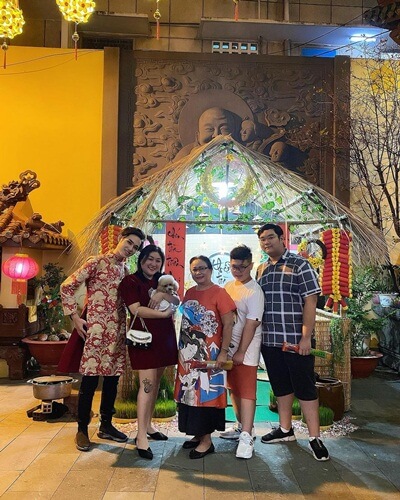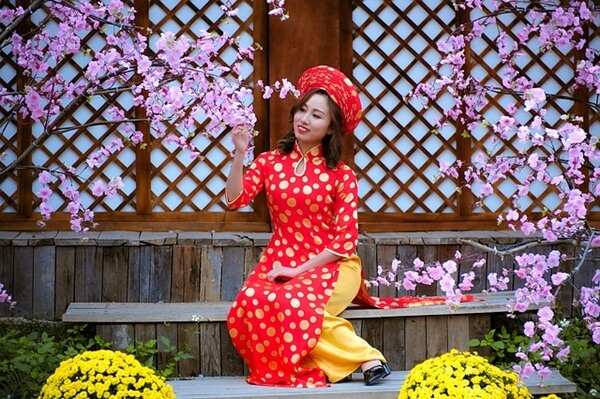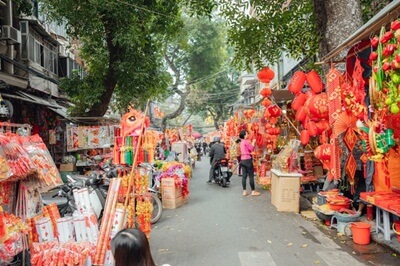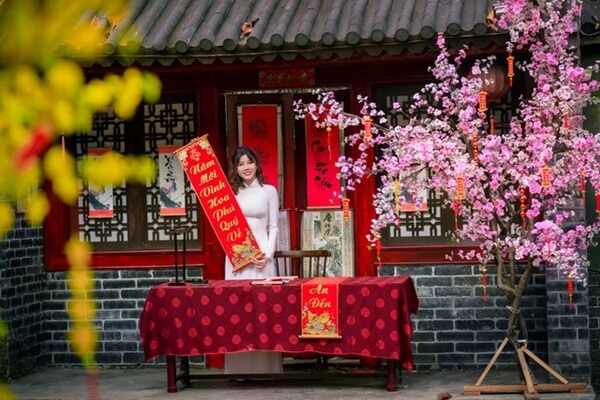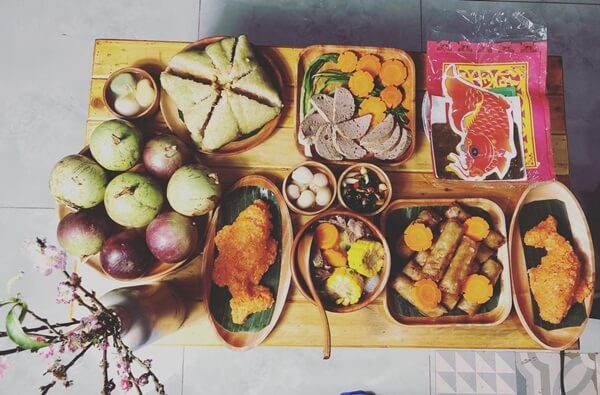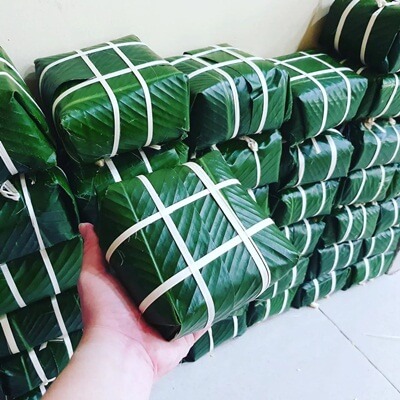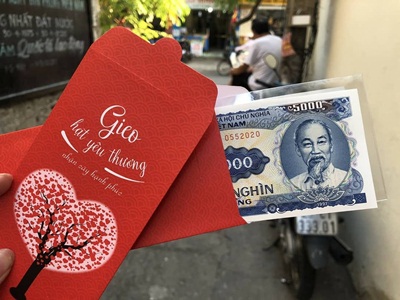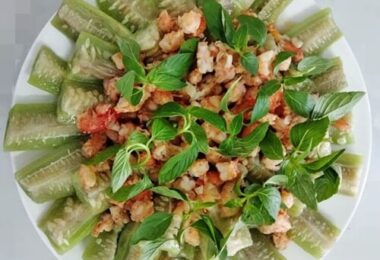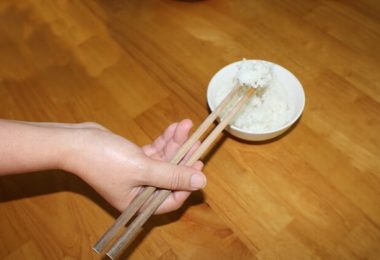Tết Nguyên Đán, or the Vietnamese Lunar New Year, is more than just a celebration; it’s a heartfelt journey into the soul of Vietnam. This festival marks the intersection of past and future, where the old year gracefully fades, and the new one emerges with fresh hopes and dreams. It’s a time when the rhythm of the universe—Heaven, Earth, and all living things—comes together in a harmonious dance.
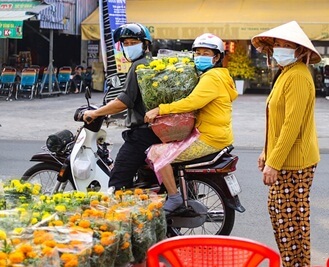
The Lunar New Year in Vietnam isn’t just a holiday; it’s an expression of life’s continuity and the deep longing for balance between humanity and nature. Rooted in Vietnam’s agricultural traditions, Tết honors the delicate relationship between the people and their environment, steeped in spirituality and community ties.
The rituals and activities of Tết reflect this profound connection, inviting you to step into a world where every flower, every dish, and every gesture carries meaning. Let’s explore the heart of this enchanting festival.
In this article, you will find out:
- Meanings of the traditional new year for the Vietnamese
- The difference between the past and present Tet
- Annual popular activities on Vietnamese traditional New Year
- FAQs about the Vietnamese Lunar New Year
Let’s go deep-dive in each section!
1. The Heartfelt Traditions and Meanings of Vietnamese Lunar New Year (Tết Nguyên Đán)
As the year draws to a close, a flurry of preparations and a whirlwind of tasks fill the air, often leaving everyone rushing and feeling the weight of time. But despite the busyness, there’s a deep sense of anticipation. Tết is more than just the turn of the calendar—it’s a vital celebration that binds families and honors the very essence of Vietnamese culture.
1.1 Tết: A Time for Family Reunion
The most sacred meaning of Tết is the reunion it brings. In our fast-paced lives, work often pulls us in different directions, and family gatherings become rare, even on holidays. Yet, Tết is the one moment of the year when families—grandparents, parents, and children—come together to share a joyful time.
Even during summer vacations, it’s not always possible for parents and children to fully connect. But Tết offers something irreplaceable: the chance to return home, visit loved ones, and reconnect in ways that go beyond ordinary celebrations. It’s a magical time when families gather, not only to celebrate but to simply be together.
This period also sees a surge in travel—buses, trains, and planes running at full capacity to reunite loved ones. If you’re planning to visit Vietnam during Tết, securing tickets early is crucial to avoid the rush and sky-high prices.
1.2 The Warmth of Tết for Adults
For many adults, Tết might seem like a time filled with stress, worry, and never-ending preparations. The excitement may not always be as palpable as it is for children, but deep down, the anticipation remains. Tết is still a moment to gather with family, relive memories, and cherish the fleeting days of spring.
As much as adults may grumble about the pressure of preparing for Tết, when it arrives, the longing for home, family, and those familiar traditions shines through. The sight of a box of sweet treats, the aroma of spring flowers, and the joyous hustle of the festival awaken a nostalgic, childlike anticipation. Regardless of age, the heart still beats for Tết.
1.3 The Joyous Tết of Children
For children, Tết is a time of pure joy and excitement. It’s not just about receiving lucky money (Li Xi), wearing new clothes, or taking a break from school. It’s a magical holiday when they feel the pulse of spring in every moment—whether it’s visiting the vibrant Tet markets, admiring the flowers, or gathering with family and friends.
The thought of traveling during Tết, discovering new places with loved ones, and exploring the world beyond the familiar is a dream come true. Tết for children is a time of wonder, where every day is filled with bright colors, new beginnings, and endless possibilities. It’s a holiday that paints their world in hues of joy, love, and laughter.
In the end, whether you’re a child eagerly awaiting the first day of the New Year or an adult reflecting on the deeper meanings of Tết, the Lunar New Year is a reminder that the most precious gift of all is time spent with family. It’s a time to honor the past, celebrate the present, and look forward to a year full of hope and new beginnings.
2. The Evolution of Vietnamese Traditional Tết: Then and Now
As time flows on, so too does the way we celebrate. Vietnamese Tết, once a time of meticulous preparation and deep-rooted customs, has gradually evolved, reflecting the changes in daily life. Yet, despite these differences, the essence of the holiday remains untouched. Let’s take a journey through the past and present of this beloved celebration.
2.1 The Traditional Tết of the Past
In earlier days, Tết was more than a festive holiday—it was the one time of the year when families could pause and savor the fruits of their labor. The rest of the year was spent working diligently, but Tết marked a sacred pause, a moment to indulge in the delicacies of the season. Preparation was key, with families raising pigs and preparing bánh chưng (square rice cakes) well in advance, starting as early as the 12th lunar month.
The typical dishes of Tết, like pickled onions, appeared in every home, alongside other symbols of tradition: the Cây Nêu (bamboo pole), firecrackers, fatty meats, and red couplets. The festive mood began on the 23rd of the 12th lunar month, as families bid farewell to Ông Công, Ông Táo (the Kitchen Gods), sending them to the heavens. From the 24th onward, the air buzzed with activity—children eagerly awaited the fireworks, while adults visited ancestral graves and cleaned the house in preparation.
The final days of the year were a whirlwind of cooking and sharing—slaughtering pigs, wrapping bánh chưng, and preparing sweets and nuts, all part of the beautiful chaos that defined the traditional Tết.
2.2 The Modern Vietnamese Tết
As Vietnam has evolved, so too has the way it celebrates Tết. Life today is more fast-paced, and the focus on food and drink has shifted. In the past, bánh chưng was a rare treat, something eagerly awaited all year. Today, it can be found year-round in markets, and dishes like pork and chicken are everyday staples. As a result, these foods no longer hold the same special significance.
Yet, many families continue to prepare bánh chưng during Tết, not out of necessity, but to capture the nostalgic spirit of the holiday and pass down the tradition to the younger generation.
The preparations for Tết today are far less complex. With modern conveniences, everything from fruits and cakes to beverages and snacks are easily found in stores. Many families now embrace the trend of traveling during the holiday, opting for new experiences rather than the traditional home-centered celebrations.
Despite these changes, the core of Tết remains the same. Vietnamese people continue to honor their ancestors through rituals and worship, and most importantly, they come together to reunite with family, creating memories that will last for years to come.
Though the face of Tết may have transformed over the years, its heart—the love of family, the honoring of traditions, and the joy of reunion—remains as vibrant and cherished as ever.
3. Annual Traditions of Vietnamese Lunar New Year (Tết Nguyên Đán)
As the Lunar New Year approaches, the air fills with anticipation and the spirit of tradition. From decorating homes to wrapping bánh chưng, each activity holds deep meaning and is steeped in cultural significance. Let’s explore the beloved customs that shape the festive atmosphere of Tết.
3.1 Praying for Ông Công, Ông Táo (The Kitchen Gods)
On the 23rd day of the 12th lunar month, families gather for a ceremony known as Ông Công, Ông Táo’s Tết, to send the Kitchen Gods back to Heaven. These three deities, believed to bring blessings to the home, are honored with offerings, ensuring they will report good things to the Jade Emperor.
The offerings vary by region but often include fruits, incense, sticky rice, tea, and boiled chicken. A key part of the ritual is the offering of carp, as legend says these clever fish can transform into dragons and swiftly carry the Kitchen Gods back to the heavens. This ritual marks the beginning of the festive season, setting a hopeful tone for the year ahead.
3.2 Decorating the Home
Tết is a time for renewal, and cleaning the house is one of the first steps. Families take great care in tidying every corner, discarding old items, and filling the space with fresh, new decorations—such as traditional Vietnamese clothes and vibrant Tết flowers.
After days of cleaning, the house shines with a renewed sense of joy and luck. However, there’s a belief that sweeping on the first days of the year may sweep away fortune, so families wait until after the third or fourth day to tidy up, ensuring that luck stays within their homes.
3.3 Erecting the Cây Nêu (The Neu Tree)
An ancient custom in northern and central Vietnam, the Cây Nêu is a tall bamboo tree that stands as a guardian against evil spirits during Tết. According to folklore, the demons once ruled over the land, exploiting the people. When the Kitchen Gods left to report to Heaven, there was no one left to protect the family. To ward off evil, a Cây Nêu was erected, adorned with red ribbons and protective items like garlic, depending on regional customs.
This tree is not only a physical symbol of protection but also a spiritual safeguard, standing tall to ensure that the new year is filled with peace and prosperity.
3.4 Wrapping Bánh Chưng and Bánh Tét
The heart of Tết’s culinary traditions lies in the preparation of bánh chưng (square rice cakes) and bánh tét (cylindrical rice cakes), symbolic dishes that represent the Earth and Heaven. From the 26th to the 30th of the 12th lunar month, families come together to wrap these cakes, a labor-intensive task that brings loved ones closer.
As the elderly men and women gather around, they share stories of the past, reminiscing about old memories and strengthening family bonds. The act of wrapping bánh chưng and bánh tét is not just about preparing food; it’s about nourishing the spirit of togetherness, gratitude, and tradition.
3.5 Welcoming New Year’s Eve
As the clock nears midnight on the last day of the lunar year, the air is charged with excitement and anticipation. At this magical moment, families across Vietnam prepare two trays of offerings—one inside the house, one outside—to honor their ancestors and bid farewell to the old year. The offerings are filled with symbolic fruits like coconut, papaya, custard apple, mango, and figs, each chosen for their wishes of warmth, happiness, wealth, and health. Fruits like bananas, oranges, and durians are avoided, as they are thought to bring bad luck on the most important night of the year.
At the stroke of midnight, vibrant fireworks light up the skies, their bright bursts and sounds meant to chase away evil and bad omens. For a brief 15 minutes, cities across Vietnam come alive in a spectacular display as everyone welcomes the new year with open arms and hopeful hearts.
3.6 Welcoming the First Visitor (Xông Đất)
An age-old tradition, Xông đất occurs right after New Year’s Eve. The first person to step into a home on the first day of the year is invited to bring good fortune. Families often choose someone with a cheerful disposition, good health, and a virtuous character to be their first guest. This person is not expected to stay long—just enough to light incense and offer their well wishes for the year ahead.
This ritual is a beautiful symbol of hope and luck, setting the tone for a prosperous and peaceful new year.
3.7 Giving Lucky Money and New Year’s Wishes
The custom of giving lì xì (lucky money) and exchanging New Year’s wishes is one of the most cherished traditions during Tết. Typically, parents and grandparents give lucky money, wrapped in red envelopes, to children and younger family members, wishing them health, happiness, and success in their studies. The symbolic gesture of lì xì is filled with love and good intentions, passing down blessings from one generation to the next.
3.8 Visiting Ancestors’ Graves
On the first morning of the new year, many families take time to honor their ancestors by visiting their graves, lighting incense, and offering prayers. This custom is an important expression of gratitude, remembering those who have passed but whose presence still guides and watches over the living. It is a moment to reflect on family bonds, history, and the connection that transcends generations.
3.9 Visiting the Temple
For those seeking blessings for the new year, visiting a temple is a common tradition. People flock to renowned Buddhist pagodas to pray for good luck, health, and prosperity. After offering incense and making their wishes, they often stroll through the peaceful temple grounds, absorbing the serene beauty of the surroundings. The temple visit is a time for spiritual renewal, a way of grounding oneself in hope and gratitude for the coming year.
These activities—whether honoring ancestors through prayers and visits to their graves, welcoming the first guest to bring good luck (Xông đất), exchanging lì xì (lucky money) to spread wishes of prosperity, or seeking blessings at the temple for health and fortune—create a vibrant tapestry of customs that go beyond celebration. They embody the values of respect for family and ancestors, the desire for peace, prosperity, and good health in the coming year, and the deep cultural bonds that tie the Vietnamese together. Each tradition is a thread in the rich fabric of Vietnam’s heritage, weaving warmth, love, and good fortune into every home.
4. FAQs about the Vietnamese Lunar New Year (Tết Nguyên Đán)
4.1. When is the Vietnamese Lunar New Year in 2026?
The Vietnamese Lunar New Year in 2026 will be celebrated from 17th to 19th February.
4.2. What is the most important traditional food during Tết in Vietnam?
For many, the star of the Tết feast is Bánh Chưng (square rice cake) and Bánh Dày (round rice cake). These traditional treats, symbolizing the Earth and Heaven, are must-haves during the New Year celebrations. While they can be enjoyed throughout the year, they carry an added significance during Tết, when families come together to honor ancestors and welcome the new year.
4.3. What do Vietnamese people usually say on Tết?
The most common greeting during Tết is “Chúc Mừng Năm Mới,” meaning “Happy New Year.” You’ll also hear people wishing prosperity and good fortune with phrases like “Năm Mới, Phát Tài – Phát Lộc” (“New Year, More Money – More Luck”) or “Năm Mới, Vạn Sự Như Ý” (“New Year, All Things as Wishes”).
4.4. Does Tết in Vietnam and China fall on the same date?
Yes, Tết in Vietnam and the Lunar New Year in China are celebrated on the same date, as both countries follow the lunar calendar. However, while the timing may be the same, the customs, rituals, and festivities differ, each reflecting the unique cultural heritage of the country.
No matter where they live or what stage of life they’re in, the Vietnamese eagerly await the arrival of Tết, the most enchanting time of the year. From the vibrant landscapes to the gentle breeze, everything feels renewed. It’s a season painted with beauty, where nature and the people come together to celebrate.
Tết holds a sacred place in the hearts of the Vietnamese. Even though it comes around every year, its significance never fades. These days are cherished deeply, as they symbolize more than just a change in the calendar—they’re a moment to reconnect with loved ones, reflect on the past, and welcome new beginnings.
As the long-awaited holiday draws near, preparations begin. The flurry of activity is both exciting and meaningful. From cleaning and decorating the house to shopping for new clothes, arranging ancestor offerings, and planning visits to family and friends—each task, though busy, adds to the joy of ushering in a fresh start. It’s a time filled with hope, anticipation, and the warmth of togetherness.

